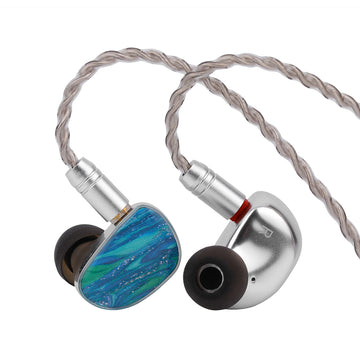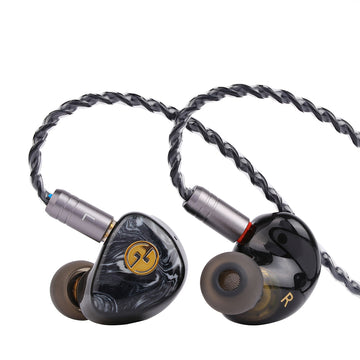A Hybrid IEM
An affordable and relatively excellent neutral IEM.
SeeAudio is a new in-ear monitor (IEM) manufacturer coming out of China. With three new models (across a big price range) already available, SeeAudio is beginning set itself up as a potential big player in the Chinese audio game in times to come. Today, we’ll take a look at the most affordable model available: the Yume.

Yume: 1+2
The Yume is a hybrid IEM consisting of 1 dynamic driver (DD) for the bass and 2 balanced armature (BA) drivers for everything else. SeeAudio states that the DD they are using is a 10mm “liquid silicone diaphragm” driver with a “Low Frequency Filter Conversion Technology”. This is essentially a standard DD mounted on a custom printed acoustic chamber designed to be an acoustic lowpass filter to reduce resonance peaks from the driver. Looking at the frequency response curve, it seems as if their lowpass design works excellently. The BA consist of the famed Knowles ED29689 (popularized by the Etymotic ER4 series) and the Knowles FH 33518 (which is similar to the popular WBFK 30095 driver). I'm really glad to see that SeeAudio has taken their time to use two separate BA drivers for the mids and trebles, respectively. When we see cheaper hybrid IEMS, they tend to use one dual BA to cover the entire mid-treble range, which just tends to lower resolution, rather than separate dedicated drivers. From inside the shell, Yume is utilizing a custom PCB board for their crossover networking, which isn’t unusual. However, this is the first time I have ever seen a PCB board attached directly to the 2-pin jack, which is a very efficient design. This is all to say, SeeAudio is using quality components, they know their engineering very well, and they seem to know how to tune IEM’s properly. The Yume might be the most complex and best designed 1DD + 2BA Hybrid IEM I have yet to encounter - from ANY company. Props to SeeAudio for putting their efforts in and not simply brushing aside their budget model.

Packaging
The case is a standard plastic cylinder used by most of the Chinese manufacturers currently, but at the price point, it’s a cut corner that I find acceptable. I am quite a fan of the silicone ear tips that SeeAudio has chosen to utilize, because for my ears, they fit PERFECTLY with the Yume. The cable is a 4 core copper cable that is on the thicker side, and unfortunately, it does not feel as premium as it looks. It’s a bit bulky for a smaller IEM, and it’s both stiff and cheap-feeling. The IEM shell design is very similar to QDC products’ and is both built and fits great.
Sound

As a whole, the SeeAudio Yume’s sound signature can be described as studio neutral with a slight subbass boost. It sounds quite reminiscent of the Etymotic ER4 series in that the relatively flat mids and 8dB pinna compensation makes for a dry and sterile sound profile that would serve excellently as studio monitors.Tonal balance is always determined by the relative quantity of each segment of the frequency range. In general, I personally find that a large pinna gain (8 to +10dB) requires a slight warmth in the mids in order to sound balanced and natural; a flat mid section, as found in the ER4XR or Yume, tends to make the signature more lean, placing the emphasis on crispness and “bite” of vocals and instruments. But by doing so, it also dangers on making them sound “shouty” or “honky”. While vocals on the Yume don’t sound unpleasantly “shouty”, it does harbor some of these characteristics, with vocal emphasis being on the finish rather than the body, making for a very lean tonality. On the other hand, the Yume does have a very nice “bite”, especially on female vocals, which vocalists may find very useful in performance settings. While it’s less honky than the ER4 series, if I could have tuned the Yume, I would have reduced the pinna compensation closer to 6dB to better match the lows and mids of the Yume.
I find the mids on the Yume particularly interesting, not necessarily because of its tuning, but more so because of its texture. The Yume has this sort of slight gritty and crunchiness to the texture that’s very evocative of P90 pickups or vintage tube microphones. It’s not in your face, but it’s ever present enough to make you keep listening harder to try and pick up more of it. I find it rather quite delicious. In all honesty, in the non-tuning aspects of the IEM, I would have found the Yume simply average, but this unique texture is its saving grace. This might be the first time where I’ve experienced this sort of complete vintage texture in an IEM. Very cool.
While the frequency measurement shows the Yume’s bass shelf starting around 200Hz, in the ear, it sounds closer to somewhere around 60Hz. The subbass rise is very gradual in the mid-bass region, making it practically flat. While this does make the overall sound very neutral, it can also impart a hollow or empty feeling due to the lack of mid-bass presence. In consequence, bass guitar lines do feel set back in the mix. Subbass on the Yume doesn’t quite rumble nor is it impactful. It’s just kind of there to set the backdrop beat. The good news is, what subbass the Yume has is still quick and punchy. If you want a completely neutral tuning with only that kick drum emphasis, this is the set for you.
In terms of technicalities, as I mentioned above, the Yume stands average for its price range. Soundstage is a little bit above its competition, but nothing crazy wide. Imaging stands on the narrower side. Layering and instrument separation tends to be more singular. Treble extension is very good though, and again, the texture is very nice.

Conclusion
I know that my sound impressions may seem to have played down the Yume, but in the end, that’s what a good monitor should be like - it shouldn’t be wild or unique; it’s supposed to be “boring”. And that’s what the Yume does best - it’s an affordable and relatively excellent neutral IEM. Dry is a term I find very fitting to how the Yume sounds; it’s tonally uncolored, vocals come off as untampered with, and even in the texture itself, there’s a sort of slight raspy/crunchiness to it. Describing an IEM as dry or sterile can be quite divisive as some, especially professionals, purposely seek out neutral transducers for monitoring purposely, while others may find it lackluster. The Yume seems to sit right on top of this fine line. Personally, I feel that the Yume might be a little bit too neutral for non-professional usage purposes - especially if the Yume will be someone’s only/main IEM. However, for musicians and sound engineers, the Yume might be among the best choices available in its price bracket for monitoring usage.
























